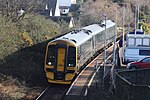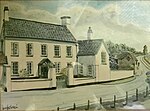Lympstone Commando railway station
DfT Category F2 stationsPages with no open date in Infobox stationPrivate railway stationsRailway request stops in Great BritainRailway stations in Devon ... and 5 more
Railway stations in Great Britain opened in 1976Railway stations opened by British RailRailway stations served by Great Western RailwayUse British English from July 2020Woodbury, East Devon

Lympstone Commando railway station is a railway station situated on the Avocet Line, a branch line from Exeter to Exmouth in Devon, England. Whilst signs on the station platform state that passengers alighting must have business with the Lympstone Commando Camp, this is no longer true and members of the general public can access the station via a public footpath.
Excerpt from the Wikipedia article Lympstone Commando railway station (License: CC BY-SA 3.0, Authors, Images).Lympstone Commando railway station
Lympstone Exton Cycle Path, East Devon Woodbury
Geographical coordinates (GPS) Address Nearby Places Show on map
Geographical coordinates (GPS)
| Latitude | Longitude |
|---|---|
| N 50.6623 ° | E -3.441 ° |
Address
Lympstone Commando
Lympstone Exton Cycle Path
EX8 5AN East Devon, Woodbury
England, United Kingdom
Open on Google Maps










